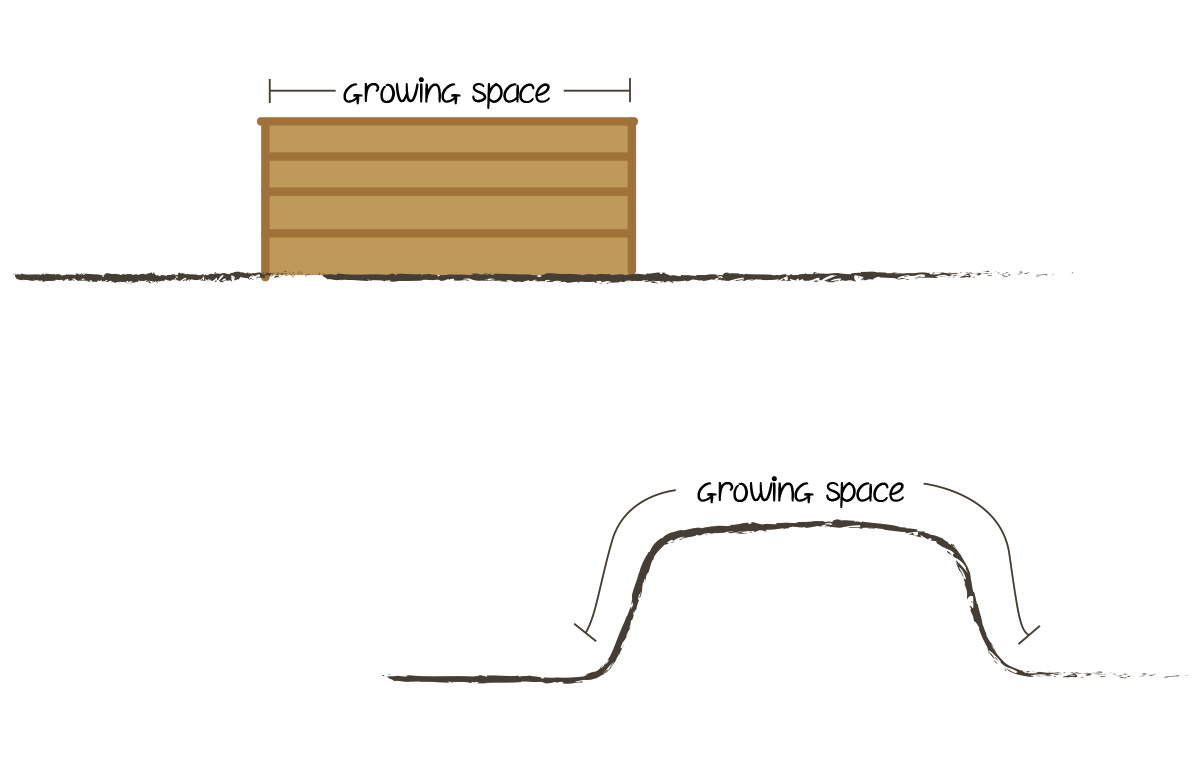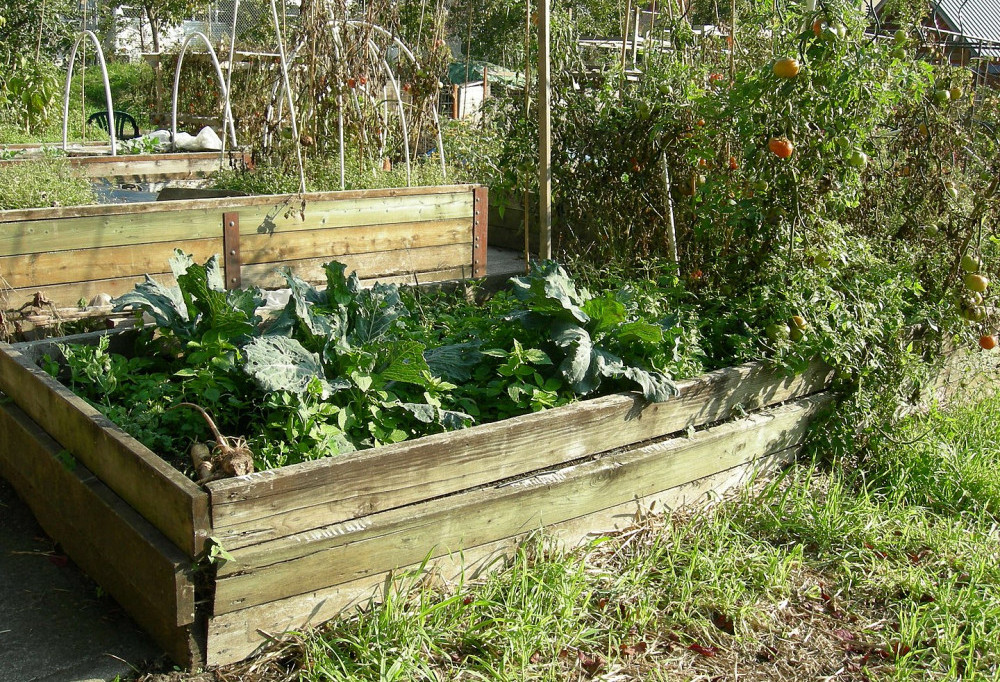Raised garden beds come in all shapes and sizes. You can build a box that is about 4 or 5 feet wide, and as long as you want, using a variety of materials. It can be 1 foot high, or you can build it waist high to facilitate easier gardening for those with a bad back or knees. I’d like to present you with some raised garden bed ideas to help you decide what will work best for you.
Some people build their raised beds from scrap wood and pallets; and some buy new cedar planking and make fancier boxes. Others might use stones or bricks, or maybe just some logs they got in the bush.
Whatever style you decide on, there will always be some considerations. Permaculture advises us to spend more time thinking, so we can spend less time working. Meaning, take the time to think something through, so you don’t spend more time, money and energy than is necessary. So let’s talk about this for a bit.

My thoughts on raised beds
I use raised beds. But there are no boxes around them. I heaped the soil over old logs, and this year I added a layer of compost on top. Each year I will add more compost, and the beds will get a little taller.
There is one main reason that I prefer open raised beds, rather than boxed raised beds: You get more growing space with an open raised bed than you do with a boxed raised bed. Take a look at the diagram below. As you can see, when you box a bed in, you lose all the potential growing area on the sides.

Because I have a small garden, I want to maximize my growing space as much as possible. So open raised beds work best for me. PLUS! Open raised beds have fewer places for slugs to hide!
But raised beds are super helpful for many people, and so easy to work in. So here are some raised garden beds ideas that make the garden accessible to everyone.

DIY Raised garden beds
A raised garden bed can be much more than a box full of soil. With some creativity and know-how, you can build some really attractive and efficient raised garden beds. Stone, brick, log, or slab – you have a wide variety of materials to choose from.
Once you’ve chosen your materials, you can choose what style of raised bed you’d like to build.
Raised garden bed ideas & materials
There are many materials you can use to create raised beds. If you want tall beds, wood is probably your best bet. Rocks are best saved for the shorter beds; although bricks and small rocks can be utilized for building tall beds if you want to put in the time and energy.
We used dry stacked boulders to build a wall, which holds back the bank around the yard; but this style of stone work probably wouldn’t work well for a raised bed. If you wanted to put in the work, you could use stones or bricks with mortar to build stone raised garden beds. It would look stunning.
I think logs look great for raised beds, although they do take up more room than boards. But if you have the space, you can use logs to build raised beds of any height, and they will look fantastic. Cedar or black locust are rot resistant, so they won’t need to be replaced for a long time. But any untreated wood will work.
Wooden pallets are often used, and you can find no end to the ways to use them if you search online. But you must find the untreated ones, so they don’t leach nastiness into your garden. (That’s something to keep in mind with all your garden building materials: make sure there are no toxins in them that could cause problems in your garden.)

People often build raised garden beds using corrugated iron, or metal roofing. We used some leftover metal roofing to build a planting box on the roof of the shop, as well as a tall planting box in the green house. It’s pretty handy stuff.
What else can be used for raised bed gardening? Well, I know people who have built their gardens using old fridges and freezers laid on their backs. That sounds like a great way to keep them out of the landfill. It’s an interesting concept, don’t you think? And they could look pretty funky with a cool paint job.
I have also seen raised beds made with woven bamboo or willow, and chicken wire too. Just goes to show that you can make your raised beds out of just about anything.
You can build or purchase elevated beds too. These are planters that are built on legs, making them waist height, and easily accessible. They are usually built of wood or metal. One nice thing about elevated planters is that you can move them around if necessary.

The point is that there are many ways to create raised garden beds. It all depends on what style you like, how much time you have to build them, and of course, how much money you’re willing to invest. Personally, I prefer reusing salvaged materials to build beds and planters. Old metal roofing or boards salvaged from other projects are perfectly respectable materials to use.
One more option for creating a quick and easy raised garden bed is to get some large grow bags. These grow bags from Bootstrap Farmer holds 200 gallons, is 50″ in diameter and 24″ tall. They would grow a lot of food! They also have smaller bags for growing food in smaller spaces.
But many people want things to look nice and tidy, and they therefore spend money on either building materials, or prebuilt raised garden beds. And that’s perfectly fine. We all have to do what works best for us. And there are many attractive designs and prebuilt packages that you can buy.
Keyhole garden beds
The idea behind the keyhole garden method is to lay the beds out in a way that enables you to stand in one spot, and access most of the garden without walking – and, in the case of a raised bed keyhole garden plan – without bending down.
This is a wonderful idea for those who have lost mobility, but still want to garden. You can even make the beds the right height and width for someone in a wheel chair!
For someone with limited mobility, being able to sit on a chair or a stool, or just lean against the raised beds, will enable them to pursue their garden passion without strain on their body. That’s a pretty cool gift to give someone.
Keyhole gardening can be done with any height of bed. If there is no mobility issue, the beds can be open raised beds, and the effect is the same – the gardener can access much of the garden from one spot.
So, if you attach a row of keyhole gardens together, you will only have to move a few times while weeding and harvesting, instead of constantly scooting down the row. Cool, right?
You can make the raised keyhole beds out of just about anything. Salvaged materials will keep your costs down; but if you want something fancier, you can find all kinds of pre-made designs online.
Filling raised garden beds
Filling your raised garden bed can be a pricey endeavor if you don’t have native soil to use. The taller they are, the more material you’ll have to buy or source. But there are some ways you can reduce the amount of material you need to gather to fill a tall raised bed.
My first suggestion is to fill the bottom third or so of the bed with old logs, making a sort of contained hugelkultur. This has the effect of not only taking up space in the box, it also acts as a sponge, holding water so that the raised bed doesn’t dry out too quickly – one of the potential drawbacks of raised beds. It also helps to increase fertility over time.
You can also use lower quality soil in the bottom third or half, and use higher grade stuff on top. Topping it with compost and well rotted manure will give you an excellent growing medium; and if you continue to top it with this – and/or worm juice and castings, kelp tea, compost tea, etc. – every year, the bottom soil will get better and increase in fertility.

You’ve made your bed . . .
As you can see, there is certainly a time and place for raised garden beds, and they can be a wide variety of heights, depending on your preference and needs. Taller beds are wonderful for people with pain or mobility issues; and keyhole beds take that to the next level. They can even make gardening accessible to those in wheel chairs.
I always advocate reusing salvaged materials because it keeps them out of the landfill, but you can build your raised beds out of anything that will hold soil. You can even purchase them already made, to make it quick and easy.
You can grow anything in a raised bed that you can grow in an in-ground garden – although tall things might be awkward. Raised beds can look spectacular, with squash or nasturtiums tumbling over the sides and down to the ground.
If you have raised beds, or are planning to build some, please share your experiences and insights in the comments section below. I’m always happy to hear what others are doing.
Health, Hope & Happiness
Tracy
This article may contain affiliate links. If you click on a link and make a purchase, I will receive a small commission, at no extra cost to you. See the full Affiliate Disclosure here.


I have enjoyed do it yourself things. But when it comes to gardening, it’s definitely something I have wanted to do for a long time.
These days I’m staying at home have been a good time to work on my garden. It keeps me safe at home and it also keeps me active. I do believe that a raised garden bed can be much more than a box full of soil. Your post has helped me and encouraged me to keep on working.
Hi Abel
I’m glad you got something useful out of the article. Even if it’s only inspiration, and motivation to keep working at it. Gardening is becoming a very important skill for everyone to learn.
Best of luck with your garden, and thanks for stopping by.
Cheers
Tracy